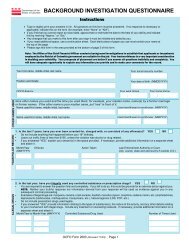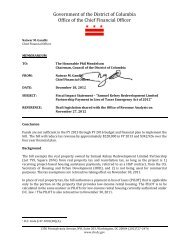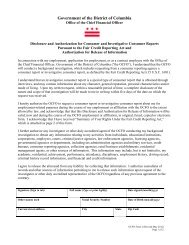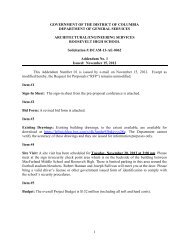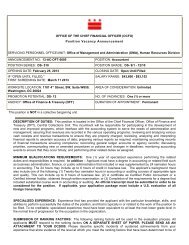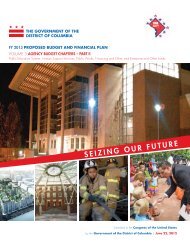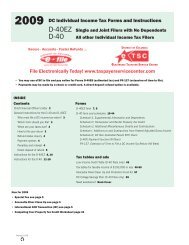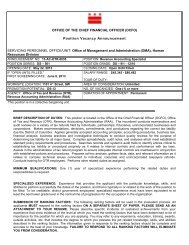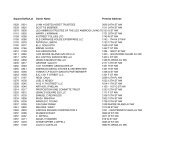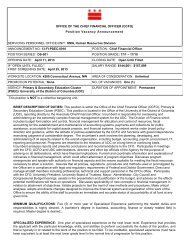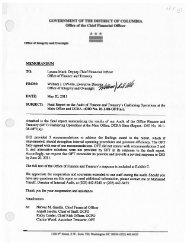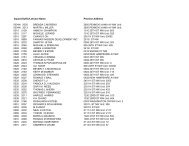Table 4-4 (continued) General Fund, Local Revenue by Source, Fiscal Years 2011-2016 (Dollars in Thousands) FY 2011 FY 2012 FY 2013 FY 2014 FY 2015 FY 2016 Revenue Source Actual Est. Est. Projected Projected Projected Individual Income 1,296,598 1,446,449 1,406,185 1,435,811 1,493,816 1,530,871 Corp. Franchise 216,280 237,534 245,424 252,038 263,356 266,310 U. B. Franchise 143,404 150,404 154,666 154,942 162,501 171,172 Total Income 1,656,282 1,834,387 1,806,275 1,842,791 1,919,673 1,968,353 Public Utility 149,745 149,745 149,880 151,552 152,929 155,032 Transfer to Ballpark Fund (8,897) (9,594) (9,603) (9,710) (9,799) (9,933) Public Utility (net) 140,848 140,151 140,277 141,842 143,130 145,099 Toll Telecommunications 60,820 60,820 61,428 62,042 63,283 63,916 Transfer to Ballpark Fund (2,373) (2,373) (2,397) (2,421) (2,469) (2,494) Toll Telecommunications (net) 58,447 58,447 59,031 59,621 60,814 61,422 Insurance Premiums 69,738 76,014 76,014 76,014 76,014 76,014 Transfer to Healthy DC Fund (25,101) (25,000) (25,000) (25,000) (25,000) (25,000) Insurance Premiums (net) 44,637 51,014 51,014 51,014 51,014 51,014 Healthcare Provider Tax 13,439 12,000 12,000 12,000 12,000 12,000 Transfer to Nursing Facility Quality <strong>of</strong> Care Fund (13,439) (12,000) (12,000) (12,000) (12,000) (12,000) Ballpark fee 33,311 25,000 25,125 25,929 26,125 27,250 Transfer to Ballpark Fund (33,311) (25,000) (25,125) (25,929) (26,125) (27,250) Hospital Bed Tax 9,008 15,562 15,562 15,562 - - Transfer to Hospital Fund (9,008) (15,562) (15,562) (15,562) - - ICF-MR Assessment 1,254 2,000 2,000 2,000 2,000 2,000 Transfer to Stevie Sellows (1,254) (2,000) (2,000) (2,000) (2,000) (2,000) HSC Contribution 5,000 5,000 5,000 5,000 5,000 5,000 Transfer to Healthy DC Fund (5,000) (5,000) (5,000) (5,000) (5,000) (5,000) Total Gross Receipts (net) 243,932 249,612 250,322 252,477 254,958 257,535 Estate 87,230 50,000 45,000 45,000 45,000 45,000 Deed Recordation 164,572 156,889 165,393 165,393 165,393 169,080 Transfer to HPTF (24,686) (23,533) (24,809) (24,809) (24,809) (25,362) Deed Recordation (net) 139,886 133,356 140,584 140,584 140,584 143,718 Deed Transfer 131,710 129,189 137,005 137,005 137,005 139,952 Transfer to HPTF (15,691) (19,378) (20,551) (20,551) (20,551) (20,993) Deed Transfer (net) 116,019 109,811 116,454 116,454 116,454 118,959 Economic Interests 14,905 25,000 10,000 10,000 10,000 10,000 Total O<strong>the</strong>r Taxes (net) 358,040 318,167 312,038 312,038 312,038 317,677 TOTAL TAXES NET OF DEDICATED TAXES 4,905,771 5,218,812 5,307,745 5,411,806 5,583,707 5,740,984 Licenses and Permits 76,020 74,096 75,440 72,225 73,594 71,478 Fines and Forfeits 126,251 154,396 147,471 147,693 145,053 142,545 Charges for Services 75,612 61,029 60,425 60,656 60,886 59,452 Miscellaneous 130,733 113,443 89,980 91,527 80,687 87,101 TOTAL NON-TAX 408,616 402,964 373,316 372,101 360,220 360,576 Lottery 62,175 62,375 63,175 63,175 63,175 63,175 Interfund Transfer 14,289 20,762 18,797 19,934 - - TOTAL LOCAL FUND REVENUE NET OF DEDICATED TAXES 5,390,851 5,704,913 5,763,033 5,867,016 6,007,102 6,164,735 Revenue 4-8 FY 2013 Proposed Budget and <strong>Financial</strong> Plan
Local Fund Property Taxes Real-Property Tax In FY 2011, $1.715 billion was collected before dedicated distributions; a 5.8 percent decrease from FY 2010. This decrease in collections was driven by an approximately 12 percentage point drop in <strong>the</strong> growth rate <strong>of</strong> commercial property (Class 2) collections, compared to 2010 collections. Class 2 collections account for approximately 67 percent <strong>of</strong> total real property tax collections. Despite declining residential (Class 1) property values due to <strong>the</strong> lingering effects <strong>of</strong> <strong>the</strong> most recent economic recession and national real estate collapse, collections in this class continued to increase primarily because <strong>the</strong> assessment cap policy for homestead properties causes <strong>the</strong> tax liability for a significant number <strong>of</strong> homesteads to increase 10 percent annually, even though <strong>the</strong> respective home values did not grow as much. Class 1 tax collections account for approximately 32 percent <strong>of</strong> total real property tax collections. Residential Property. Due to <strong>the</strong> deflating housing bubble and <strong>the</strong> lingering economic recession, residential property value declines continued in CY 2011 due to even fewer residential property sales. This sustained relative weakness in <strong>the</strong> residential sector is expected to continue over <strong>the</strong> next few years. However, Class 1 tax collections are expected to grow approximately 2.5 percent annually for FYs 2012 to 2016 due to rising property values <strong>of</strong> large apartment buildings. Total Class 1 tax collections are also expected to grow because <strong>of</strong> <strong>the</strong> assessment cap for many homestead properties that causes <strong>the</strong> annual tax liability to increase 10 percent annually notwithstanding <strong>the</strong> change in <strong>the</strong> market value <strong>of</strong> such properties. Commercial Property. Market rate sales <strong>of</strong> commercial property virtually disappeared in 2009 but began to rebound in 2010. In <strong>the</strong> summer and fall <strong>of</strong> 2010, <strong>the</strong>re was an increase in <strong>the</strong> number <strong>of</strong> large commercial property sales at prices on average 30 percent above <strong>the</strong> 2010 assessment value. As a result, Class 2 assessment values will rebound in FY 2012 almost to FY 2010 levels, but growth will begin to gradually moderate in FY 2013. The factors that affect residential and commercial property assessment values mean that, after a decline <strong>of</strong> 6.9 percent in FY 2011, total real property tax revenue after dedicated distributions will grow 7.2 percent in FY 2012 and by only 6.2 percent in FY 2013. General obligation bonds. In addition to providing revenue for government services, real property taxes support <strong>the</strong> District’s general obligation bonds used for capital investment. For FY 2012, <strong>the</strong> percentage <strong>of</strong> real property tax collections dedicated to <strong>the</strong> repayment <strong>of</strong> principal and interest on <strong>the</strong> District’s General Obligation Bonds is 14 percent. Transfer to Tax Increment Financing (TIF) Fund: In FY 2012, $33.0 million <strong>of</strong> real property tax collections will be dedicated to <strong>the</strong> repayment <strong>of</strong> Tax Increment Financing and PILOT bonds. This amount will increase to $36.6 million in FY 2013 due to continuing development progress at previously authorized TIF projects, expected increased assessments for existing TIF properties, and TIF transfers that may be required for potential new debt issuances. Personal Property Tax In FY 2011, gross total personal property tax collections totaled $52.7 million. Based on national and regional economic indicators that suggest a gradual increase in <strong>the</strong> level <strong>of</strong> business activity and a subsequent increase in <strong>the</strong> total level <strong>of</strong> new business investment, gross collections are expected to grow 0.9 percent to $53.2 million in FY 2012. Total gross personal property tax collections are expected to grow at an annual average rate <strong>of</strong> approximately 1.0 percent per annum for FY 2013 to FY 2016 as <strong>the</strong> District <strong>of</strong> Columbia’s economy recovers. FY 2013 Proposed Budget and <strong>Financial</strong> Plan Revenue 4-9
- Page 1 and 2:
THE GOVERNMENT OF THE DISTRICT OF C
- Page 3 and 4:
The Government Finance Officers Ass
- Page 5 and 6:
Office of the Chief Financial Offic
- Page 7 and 8:
Council of the District of Columbia
- Page 9 and 10:
GOVERNMENT OF THE DISTRICT OF COLUM
- Page 11 and 12:
Volumes Bound Separately Volume 2 -
- Page 15 and 16:
How to Read the Budget and Financia
- Page 17 and 18:
Operating Appendices (Volumes 4 and
- Page 19 and 20: FY 2013 Proposed Budget Changes The
- Page 21 and 22: • Appendices that provide support
- Page 23 and 24: This table presents the agency's to
- Page 25 and 26: This indicates the specific program
- Page 27 and 28: The FY 2013 Proposed Budget Changes
- Page 29 and 30: Agency performance measures describ
- Page 31 and 32: ■ ■ ■ ■ ■ ■ ■ ■ ■
- Page 33 and 34: appropriation titles are the agenci
- Page 35 and 36: Figure 1-1 Where the Money Comes Fr
- Page 37 and 38: Table 1-2a Local Funds Expenditure
- Page 39 and 40: Table 1-4 Local Funds Proposed FTEs
- Page 41 and 42: Table 1-5 Major Gross Funds FTE Cha
- Page 43 and 44: Strategic Budgeting 2 The District
- Page 45 and 46: Information Systems In FY 2004, the
- Page 47 and 48: Revenues 2. Taxes. This category in
- Page 49 and 50: 7. Interfund Transfers. This line i
- Page 51 and 52: Expenditures (by Appropriation Titl
- Page 53 and 54: 43. Contingency Cash Reserve Balanc
- Page 55 and 56: Table 3-1 (Continued) FY 2013 - 201
- Page 57 and 58: Table 3-3 FY 2013 - FY 2016 General
- Page 59 and 60: Table 3-4 FY 2013 - FY 2016 General
- Page 61 and 62: Table 3-5 FY 2013 - FY 2016 Federal
- Page 63 and 64: Revenue 4 TOTAL GENERAL FUND TAX RE
- Page 65 and 66: The Economic Outlook Despite a brig
- Page 67 and 68: magnitude would have significant ra
- Page 69: acks in federal spending and the fe
- Page 73 and 74: Transfer to Convention Center Fund:
- Page 75 and 76: Table 4-7 Selective Sales and Excis
- Page 77 and 78: Transfer to Healthy DC Fund: Of the
- Page 79 and 80: Table 4-10 Other Tax Revenue, Fisca
- Page 81 and 82: Property tax changes: Repeal subjec
- Page 83 and 84: Table 4-12 (cont.) Policy Proposals
- Page 85 and 86: Implement a motor fuel quality test
- Page 87 and 88: Table 4-13 (cont) Percentage Change
- Page 89 and 90: Table 4-14 (cont) Changes in Genera
- Page 91 and 92: Table 4-15 (Cont.) General Purpose
- Page 93 and 94: FY 2013 Proposed Budget and Financi
- Page 95 and 96: Table 4-17: Special Purpose (O-type
- Page 97 and 98: FY 2013 Proposed Budget and Financi
- Page 99 and 100: FY 2013 Proposed Budget and Financi
- Page 101 and 102: FY 2013 Proposed Budget and Financi
- Page 103 and 104: FY 2013 Proposed Budget and Financi
- Page 105 and 106: PART A — GENERAL FUND TAXES FY 20
- Page 107 and 108: PART A — GENERAL FUND TAXES FY 20
- Page 109 and 110: Tax Expenditure Budget FY 2012 - FY
- Page 111 and 112: Each tax expenditure was also class
- Page 113 and 114: FY FY 2013 Proposed Budget and Fina
- Page 115 and 116: FY 2013 Proposed Budget and Financi
- Page 117 and 118: FY 2013 Proposed Budget and Financi
- Page 119 and 120: FY 2013 Proposed Budget and Financi
- Page 121 and 122:
FY 2013 Proposed Budget and Financi
- Page 123 and 124:
FY 2013 Proposed Budget and Financi
- Page 125 and 126:
FY 2013 Proposed Budget and Financi
- Page 127 and 128:
FY 2013 Proposed Budget and Financi
- Page 129 and 130:
Specifically, the chapter: • Exam
- Page 131 and 132:
Table 5-1 Enrollments and Expenditu
- Page 133 and 134:
Administrator, the Office of the Ch
- Page 135 and 136:
Table 5-2 Overtime Actual Expenditu
- Page 137 and 138:
Table 5A-1 (continued) Local Funds
- Page 139 and 140:
Table 5A-3 Gross Funds Actual Expen
- Page 141 and 142:
Table 5A-4 Local Funds Actual Expen
- Page 143 and 144:
Table 5A-6 Federal Grant Actual Exp
- Page 145 and 146:
Table 5A-8 Dedicated Taxes Funds Ac
- Page 147 and 148:
Table 6-1 Overview (Dollars in thou
- Page 149 and 150:
Table 6-3 Capital Fund Pro Forma (D
- Page 151 and 152:
Table 6-4 OFFICE OF FINANCE AND TRE
- Page 153 and 154:
Figure 6-2 Number of Capital-Funded
- Page 155 and 156:
Job Creation and Economic Developme
- Page 157 and 158:
In FY 2006, the District borrowed $
- Page 159 and 160:
Appendix A: D.C. Comprehensive Fina
- Page 161 and 162:
General Fund expenditures) for all
- Page 163 and 164:
Background: The timely deposit of m
- Page 165 and 166:
of cash that is not needed to fund
- Page 167 and 168:
• Computer hardware system costs
- Page 169 and 170:
Background: The District is require
- Page 171 and 172:
of the District of Columbia). Amoun
- Page 173 and 174:
Any existing Special Purpose Revenu
- Page 175 and 176:
the availability of funds is made,
- Page 177 and 178:
Appendix B Grant Match and Maintena
- Page 179 and 180:
Reporting of Grant Match and Mainte
- Page 181 and 182:
B. Economic Development and Regulat
- Page 183 and 184:
D. Public Education System (Note: U
- Page 185 and 186:
Human Support Services (Dollars in
- Page 187 and 188:
G. Financing and Other One agency i
- Page 189 and 190:
Intra-District Medicaid Payments (P
- Page 191 and 192:
Appendix C Basis of Budgeting and A
- Page 193 and 194:
Appendix D: Glossary of Budget Term
- Page 195 and 196:
Arbitrage - The simultaneous buying
- Page 197 and 198:
Current Services Funding Level (CSF
- Page 199 and 200:
Key Result Measures - A set of resu
- Page 201 and 202:
Special Purpose Revenue - Funds use
- Page 203 and 204:
Appendix E Current Services Funding
- Page 205 and 206:
Other Adjustments The following are
- Page 207 and 208:
Government of the District of Colum
- Page 209 and 210:
AppropriationTitle (Thousands of Do
- Page 211 and 212:
AppropriationTitle (Thousands of Do
- Page 213 and 214:
Government of the District of Colum
- Page 215 and 216:
Government of the District of Colum
- Page 217 and 218:
Government of the District of Colum
- Page 219 and 220:
Government of the District of Colum
- Page 221 and 222:
Government of the District of Colum
- Page 223 and 224:
Government of the District of Colum
- Page 225 and 226:
AppropriationTitle Agy Cde Governme
- Page 227 and 228:
Government of the District of Colum
- Page 229 and 230:
A BILL ---------- IN THE COUNCIL OF
- Page 231 and 232:
$11,500,000, to remain available un
- Page 233 and 234:
TITLE III--DISTRICT OF COLUMBIA FUN
- Page 235 and 236:
other funds, and $9,565,000 from fu
- Page 237 and 238:
necessary for reimbursement to the
- Page 239 and 240:
Board of Trustees of the University
- Page 241 and 242:
from local funds, $26,403,000 from
- Page 243 and 244:
contingency reserve fund under sect
- Page 245 and 246:
Unemployment Insurance Trust Fund F
- Page 247 and 248:
District of Columbia government sub
- Page 249 and 250:
corporations, institutions, and org
- Page 251 and 252:
District, RLA, or any entity of the
- Page 253 and 254:
(44) The play field portion of Rese
- Page 255 and 256:
(b) Every remote-vendor that does n
- Page 257 and 258:
Council (or Act of Congress, in the
- Page 259 and 260:
(a) Section 602(c)(1) of the Distri



